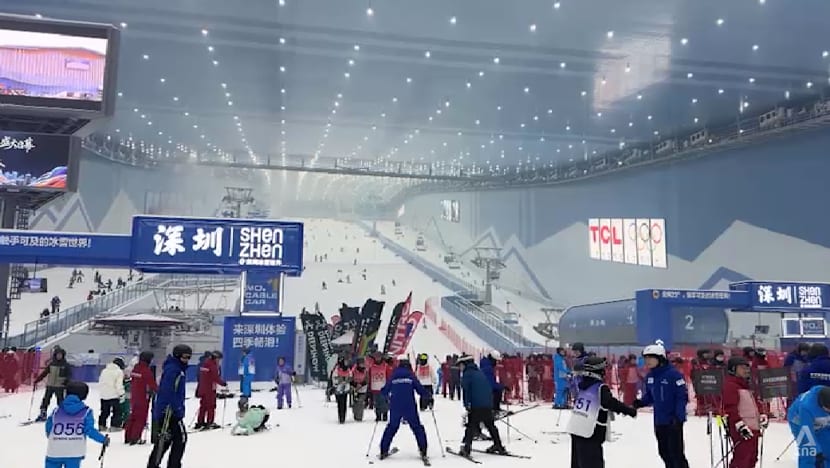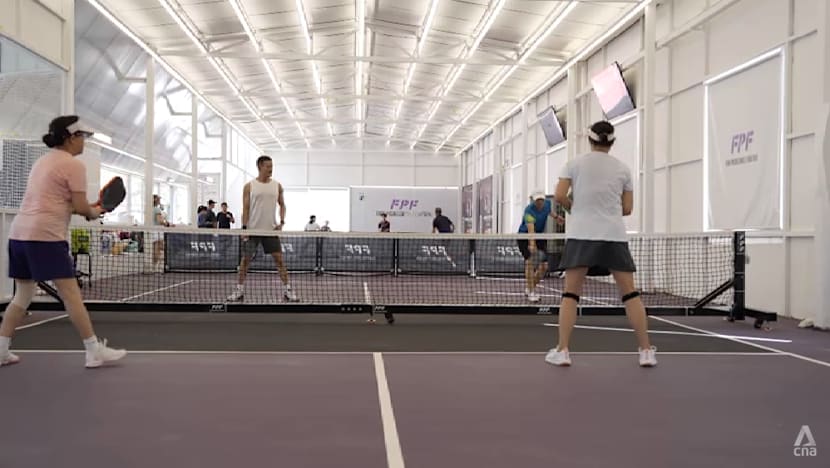China makes trillion-yuan bet on sports to power economic growth
As China’s National Games get underway in Guangzhou, Beijing’s massive push towards sports as an economic driver is also taking centre stage.

At 100,000 sq m – about the size of 15 football fields – Qianhai Snow World in Shenzhen is the world's largest indoor ski centre.

This audio is generated by an AI tool.
SHENZHEN: In subtropical Shenzhen, hundreds of visitors ski down artificial slopes at the massive Qianhai Snow World, which is kept at a year-round temperature of -6°C.
At 100,000 sq m – about the size of 15 football fields – the world’s largest indoor ski centre is the southern Chinese city’s latest attempt to reinvent itself as a tourism destination.
The facility, which costs about US$4.2 million, features five professional slopes, ski lifts and snow play zones.
It even attracts visitors from neighbouring Hong Kong and Macau. For some, it is a novelty.
“You can drive to this (ski arena) in Shenzhen and it's quite fast, taking about an hour,” said one Hong Kong customer, who was visiting during the Mid-Autumn Festival holiday.
For the Chinese government, the facility is more than a mere tourist attraction. It is part of a national push towards sports excellence and the potential to power the country’s economy on a global stage.
Casual skiers aside, the centre is built to host international competitions. The venue will soon be connected to a hotel, an indoor diving pool and a cycling track, creating an “active lifestyle” complex.
SPORTS AS A GROWTH STRATEGY
Beijing is betting big on sports as a driver of domestic consumption. In September, authorities released a set of guidelines aimed at accelerating the growth of the country’s sports industry.
The aim is to tap into the sector’s consumption potential and drive what officials call “high-quality development”.
"Benefiting livelihoods is the basis and premise of promoting consumption,” Sheng Qiuping, China’s vice minister of commerce, said in September.
“Promoting consumption is also an important way to benefit livelihoods. For example, policy measures are put forward, creating a number of high-quality events with greater popularity, professional leagues and sports competitions from … brands with independent intellectual property rights.”
According to the General Office of the State Council, Beijing aims to grow the domestic sports industry to over 7 trillion yuan (US$985 billion) by 2030.
The plan also envisions cultivating a group of Chinese sports companies and events that can compete on the world stage.
China’s sports industry is now about halfway to this target – it is projected to top 3 trillion yuan by the end of this year.
Latest government data shows the industry has grown by an average of 11.6 per cent annually.

STAGE SET FOR NATIONAL GAMES
Further north, Guangzhou is preparing to host China’s 15th National Games, which open on Sunday (Nov 9).
The Guangdong Olympic Stadium – which hosted the 9th edition of the Games in 2001, athletics events in the 2010 Asian Games, and was also once in the running for the 2008 Olympics – has undergone a high-tech transformation.
It now features solar panels powering the roof, a smart system cutting energy use by up to 20 per cent, and a 3km artificial intelligence-driven running track.
The upgrades go beyond the competition itself. The government aims to use such venues to cash in on the global sports economy.
By 2030, China aims to build around 100 sports venues that can host international competitions.

ROOM FOR SMALL PLAYERS
But the sports industry in China is not just a game for the big players. Smaller ventures are also thriving.
One of them is a pickleball centre in Guangzhou run by Singaporean Darren Ho, a professional player-turned-entrepreneur.
The court is tucked away in a quiet neighbourhood just outside the city centre, but it is attracting a steady stream of regulars from Hong Kong.
“Here, it might cost 300 yuan per hour, while in Hong Kong, it costs around 800 to 1,000 yuan to hire a personal trainer,” said one player.
Ho is now expanding his business into a larger facility with competition courts and spectator stands.
“There will be LED screens, livestreaming cameras (and) technology for players to analyse their own play on cameras. It’s going to be quite state-of-the-art,” he said.




















